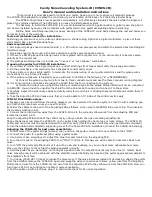
IM 253401-01E
App2-3
App
Appendix 2.2 Program Format
Communication Commands 2
Program message unit format
The format of a program message unit is shown below.
,
<Program header>
<Program data>
Space
<Program header>
A program header is used to indicate the command type. For
details, refer to page App2-4.
<Program data>
If certain conditions are required for the execution of a
command, program data must be added. Program data must be
separated from the header by a space (ASCII code “20H”). If
multiple items of program data are included, they must be
separated by a “
,
” (comma).
Example :
CONFIGURE:AVERAGING:TYPE LINEAR, 8<PMT>
Header
Data
Response Messages
The data returned by this instrument to the controller is called
a response message. The format of a response message is
shown below.
<RMT>
;
<Response message unit>
<Response message units>
A response message consists of one or more response message
units: each response message unit corresponds to one
response.
Response message units are delimited by a “
;
”.
For the response message format, refer to the next item.
Example
:
CONFIGURE:VOLTAGE:RANGE 15.0E+00;AUTO 0<RMT>
Unit
Unit
<RMT>
RMT is the terminator used for every response message. Only
one type of response message is available; NL^END.
Response message unit format
The format of a program message unit is shown below.
,
<Rsps. header>
<Response data>
Space
<Response header>
A response header sometimes precedes the response data.
Response data must be separated from the header by a space.
For details, refer to page App2-6.
<Response data>
Response data is used to define a response. If multiple items
of response data are used, they must be separated by a “
,
”
(comma).
Example :
500.0E-03<RMT> :CONFIGURE:MODE RMS<RMT>
Data
Header
Data
If a program message contains more than one query, responses
are made in the same order as the queries. Normally, each
query returns only one response message unit, but there are
some queries which return more than one response message
unit. The first response message unit always responds to the
first query, but it is not always true that the ‘n‘th unit always
responds to the ‘n‘th query. Therefore, if you want to make
sure that a response is made to each query, the program
message must be divided up into individual messages.
Points to Note concerning Message Transmission
• It is always possible to send a program message if the
previous message which was sent did not contain any
queries.
• If the previous message contained a query, it is not possible
to send another program message until a response message
has been received. An error will occur if a program
message is sent before a response message has been
received in its entirety. A response message which has not
been received will be discarded.
• If an attempt is made by the controller to receive a response
message, even if there it no response message, an error will
occur. An error will also occur if the controller makes an
attempt to receive a response message before transmission
of a program message has been completed.
• If a program message of more than one unit is sent and
some of the units are incomplete, this instrument receives
program message units which the instrument thinks
complete and attempts to execute them. However, these
attempts may not always be successful and a response may
not always be returned, even if the program message
contains queries.
Dead Lock
This instrument has a buffer memory in which both program
and response messages of 1024 bytes or more can be stored.
(The number of bytes available will vary depending on the
operating state of the instrument.) If both buffer memories
become full at the same time, this instrument becomes
inoperative. This state is called dead lock. In this case,
operation can be resumed by discarding the response message.
No dead lock will occur, if the size of the program message
including the PMT is kept below 1024 bytes. Furthermore, no
dead lock will occur if the program message does not contain
a query.
















































